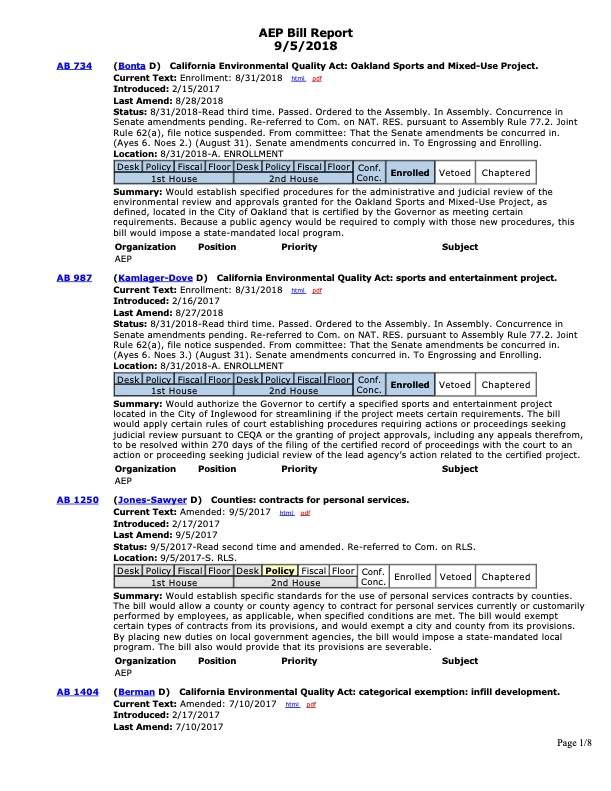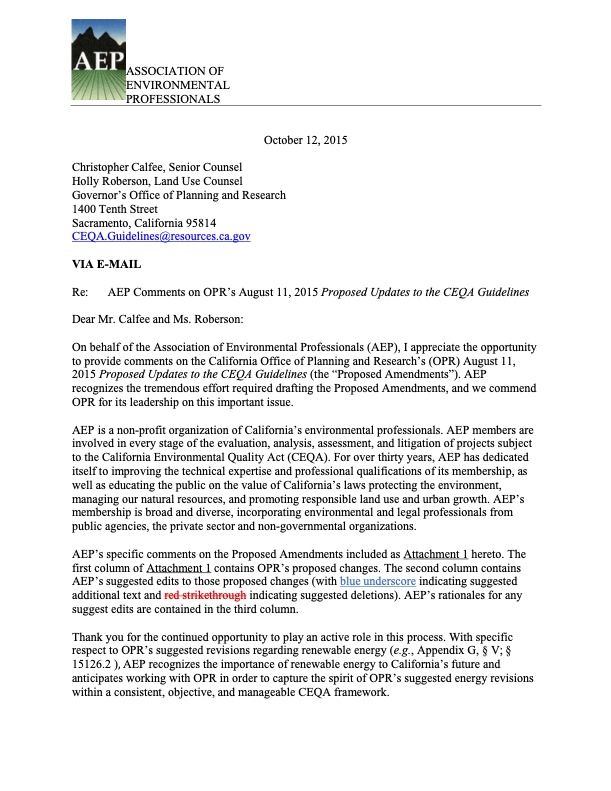Legislative Updates
April 19, 2019 – Legislative Update

Download file
September 5, 2018 – Legislative Update

Download file
January 10, 2018 – Legislative Update
- Governor Brown is in his final year, and will be presenting his final Proposed Budget
- In many veto letters last fall, he indicated that he would like to see wholesale changes to CEQA rather than some of the one-off bills that he vetoed
- So, according to our lobbyist, the Proposed Budget will be watched closely for any signals on CEQA reform
- In addition, there is a rumor that Senator Glazer is rumored to be authoring a reform bill
- 4 Senators have already announced the desire to pursue more housing legislation in 2018 – some bills have already been introduced but there will be more
- These bills so far include:
- SB 827 regarding zoning near high-quality transit
- The bill targets restrictive local housing zoning in high-quality transit areas – density limits, floor area ratios, and height
- The goal is to establish state minimum zoning near high-quality transit to ensure that neighborhoods with transit access will have abundant housing and so that California’s transit agencies will see increases in ridership
- The bill targets residential projects within a ½ mile of a major transit stop or a ¼ mile from a high-quality transit corridor as defined in SB 375
- Major transit stop: site containing an existing rail transit station, a ferry terminal served by either a bus or rail transit service, or the intersection of two or more major bus routes with a frequency of service interval of 15 minutes or less during the morning and afternoon peak commute periods
- High Quality Transit Corridor: corridor with fixed route bus service that has service intervals of no more than 15 minutes during peak commute hours
- The bill would exempt housing development in these areas from local controls on maximum residential density, maximum floor area ratio, and maximum parking spaces
- If local height maximums are lower than 45 to 85 feet, a transit-rich housing project would be granted a new, higher height limit to accommodate more homes
- The bill can be found here: http://leginfo.legislature.ca.gov/faces/billNavClient.xhtml?bill_id=201720180SB827
- SB 828 Fixing RHNA
- Generally, RHNA is the process used to determine how much housing at various income levels local communities are obligated to accommodate – the state projects population growth, then regional agencies divide the allocation among its local jurisdictions. The local government is required to plan and zone for 100% of their local allocation in the Housing Element of the General Plan
- The goal is to increase state oversight over local and regional housing obligations and to require the Department of Housing and Community Development to complete an audit of California’s unmet housing need
- Among other things, the bill would
- Authorize HCD to challenge inequitable housing allocations between comparable jurisdictions (the example given was 1397 units allocated to Redondo beach while similar coastal communities Hermosa Beach and Manhattan Beach received 2 and 37 units respectively)
- Require HCD to rollover jurisdiction-specific underproduction from the last cycle to the next if a city has underperformed and not met its RHNA allocation
- Prohibiting regional planners from purposely underallocating in cities they know are underperformers and will have rollover numbers
- Requiring housing elements to zone for 200% of their housing obligation every cycle, not 100%
- The bill can be found here: http://leginfo.legislature.ca.gov/faces/billNavClient.xhtml?bill_id=201720180SB828
- SB 829 Streamlining farmworker housing
- The bill would state it is the intent of the Legislature to enact legislation that would expand existing law to:
- Further incentivize the creation of farmworker housing in agricultural communities
- Authorize the Department of Housing and Community Development to partner private agricultural operators with independent nonprofits that will manage and operate residences
- And preserve and protect the civil rights of tenants living in employee housing
- The bill can be found here: http://leginfo.legislature.ca.gov/faces/billNavClient.xhtml?bill_id=201720180SB829
2015 Legislative Session Has Ended: Very Few CEQA-Related Amendments
September 11, 2015 was the final day for bills to be passed this legislative session, and at the end of the session very few CEQA-related bills have made it through. The three CEQA bills to have passed include:
- AB 115/SB 88, the Omnibus Resource Trailer Bill, which adds a new Public Resources Code section 21080.08 providing a new statutory exemption for projects that both mitigate drought conditions and construct or expand recycled water pipelines.
- AB 323, which amends Public Resources Code section 21080.37 extending through January 1, 2020 the existing statutory exemption for projects that repair, maintain, or make minor alterations to an existing roadway.
- SB 348, which amends Public Resources Code sections 21080.13 and 21080.14 and imposes additional duties on lead agencies using the existing statutory exemption for railroad crossing projects.
- AB 157, which provides specific CEQA streamlining procedures for a project opening a third lane on the Richmond-San Rafael Bridge in the San Francisco Bay Area
Although not CEQA-specific legislation, SB 350, the Clean Energy and Pollution Reduction Act of 2015, has also been signed into law. SB 350 increases the Renewable Portfolio Standard (RPS) to 50% by 2030, and establishes a target to double energy efficiency savings in electricity and natural gas end uses by 2030.
Notably, SB 32, which would have codified the greenhouse gas emissions thresholds of two past executive orders (40% below 1990 levels by 2030 and 80 percent below 1990 levels by 2050) did not pass. SB 32 was of high interest to CEQA practitioners because it could have changed how greenhouse gas emissions impacts are identified in CEQA documents.
AEP Comments on OPR’s August 11, 2015 Proposed Updates to the CEQA Guidelines
The AEP Legislation Committee, which consists of representatives from each local chapter, has reviewed the Office of Planning and Research’s Proposed Updates to the CEQA Guidelines: Preliminary Discussion Draft dated August 11, 2015. Over the course of several weeks, the Legislation Committee drew on its membership’s broad and diverse range of CEQA experience to prepare comments on the technical, legal, and policy implications of the proposed changes. On October 12, 2015, the Legislation Committee submitted its detailed comment letter to OPR for consideration.

Download file


